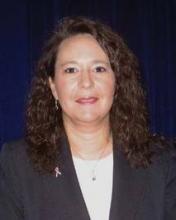SAN ANTONIO – Women undergoing neoadjuvant chemotherapy for node-positive breast cancer may be able to have sentinel lymph node surgery instead of an axillary lymph node dissection, but proper surgical technique is critical for staging accuracy, a phase II trial from the American College of Surgeons Oncology Group suggests.
Among the 637 women studied in ACOSOG Z1071, all received chemotherapy and then underwent both sentinel lymph node (SLN) surgery and axillary lymph node dissection (ALND). SLN surgery correctly identified nodal status in 91.2% of cases, lead investigator Dr. Judy C. Boughey reported at the San Antonio Breast Cancer Symposium.
The false-negative rate of SLN averaged 12.6% in women with clinical N1 disease who had at least two sentinel nodes examined – slightly higher than the 10% set as a predefined endpoint. But it was lower when both blue dye and radiolabeled colloid were used to identify sentinel nodes (10.8%) and when three or more sentinel nodes were examined (9.1%).
"SLN surgery is a useful tool for detecting residual nodal disease in those women who present with node-positive breast cancer receiving neoadjuvant chemotherapy," Dr. Boughey commented in a press briefing. "Using SLN surgery in this patient population will enable us to reduce the extent of axillary surgery and therefore decrease morbidities for women treated for breast cancer."
Women were eligible for the trial if they had node-positive (T0-4, N1-2) breast cancer. After neoadjuvant chemotherapy, they underwent definitive breast surgery (lumpectomy or mastectomy), along with SLN surgery followed by a completion ALND. Patients who had N3 disease, inflammatory breast cancer, or prior ipsilateral axillary surgery were excluded.
Nodes were defined as being positive if they contained a tumor deposit measuring greater than 0.2 mm on sections stained with hematoxylin and eosin.
Sentinel nodes were identified in 92.7% of patients overall. A total of 40% of patients had no detectable nodal disease after neoadjuvant chemotherapy and thus would be unlikely to benefit from undergoing ALND, according to Dr. Boughey, a surgeon at the Mayo Clinic in Rochester, Minn.
Among the 60% of patients with detectable nodal disease (subsequently used to assess the false-negative rate of SLN), 85% had only positive sentinel nodes.
When only a single SLN was examined, the false-negative rate of SLN surgery was 31.5%, so Dr. Boughey recommends resecting a minimum of two nodes.
The false-negative rate was also lower when sentinel nodes were pathologically examined and determined to contain histologic changes (10.8%) and when a clip placed in the node at initial diagnosis was subsequently found at definitive surgery (7.4%).
"It’s important to collaborate with our radiology colleagues regarding potential for clip placement in lymph nodes, as well as our pathologists for review of sentinel lymph nodes for the presence of treatment effect," she said.
In the session where the results were presented, Dr. J. Michael Dixon of the Western General Hospital in Edinburgh asked whether a minimum of three nodes should be taken, because "if you take three or more nodes, your false-negative rate is within the range that is acceptable. Yet your conclusions said two. So I wonder if you get a second chance, you can tell us that we can do this technique if we use dual isotope and if we take three or more sentinel nodes and follow your other rules."
"We framed the conclusion based on the way the protocol had been written up front with two or more, but I think your comments are spot on," replied Dr. Boughey.
Dr. Steven Vogl of the Montefiore Medical Center in the Bronx, New York, asked about pathologic complete response (pCR).
"We did not require any specific degree of response for the patients to be in the study, since all of the patients were getting a completion ALND," Dr. Boughey replied. "We are currently evaluating specifically that question about whether the breast response and/or the nodal response on ultrasound can help define the appropriate patient population for us to tailor this therapy to."
Dr. Vogl noted that for patients who are HER2-positive, ER-negative, and triple-negative, pCR is very important. "So if we can figure out very carefully who didn’t achieve a pCR, especially in the node, we can probably do something for those patients some day with the right agents," he said.
"Do you use clips in all patients? Do you use dual agents always? And do you always remove two sentinel nodes? What is the impact of this on what we should do next?" asked session moderator Dr. Anthony Lucci Jr., of the University of Texas M.D. Anderson Cancer Center in Houston.


